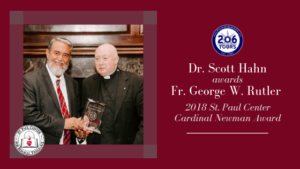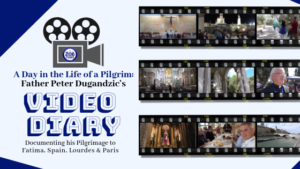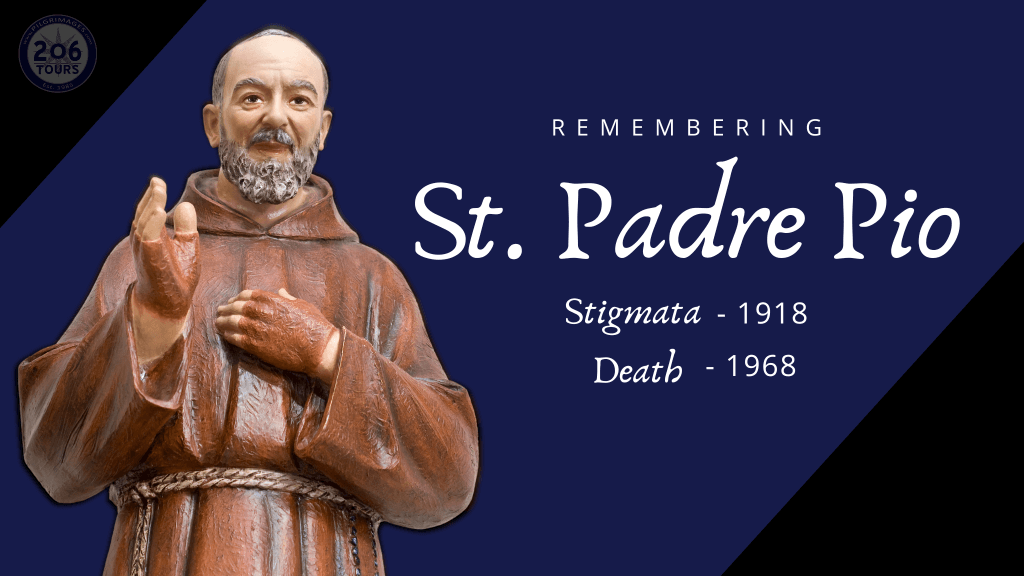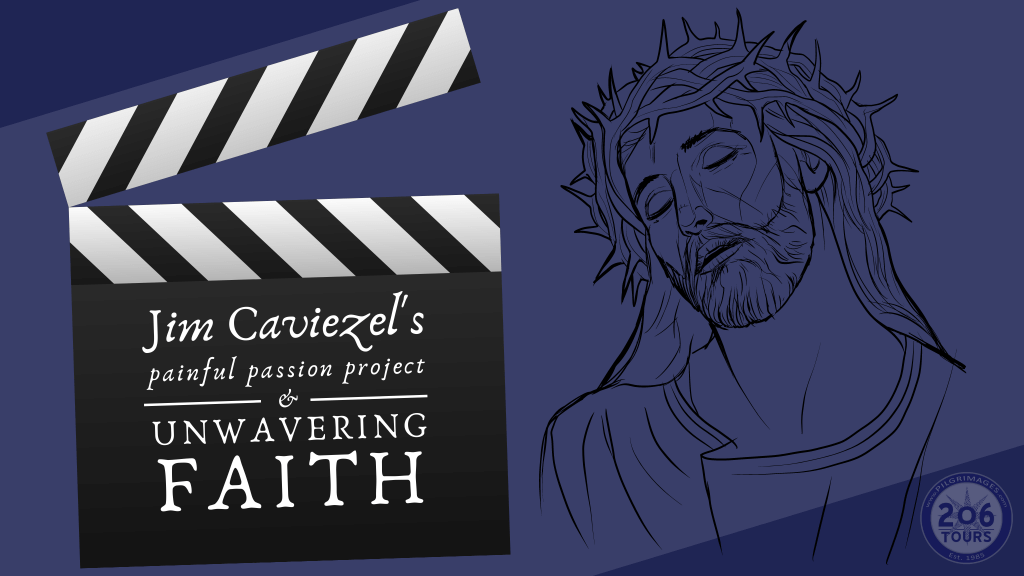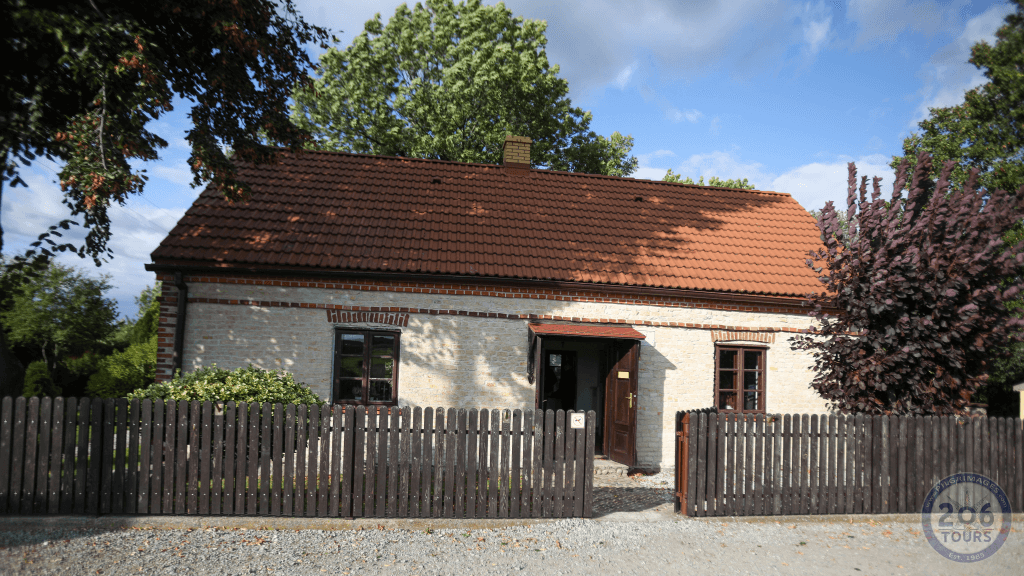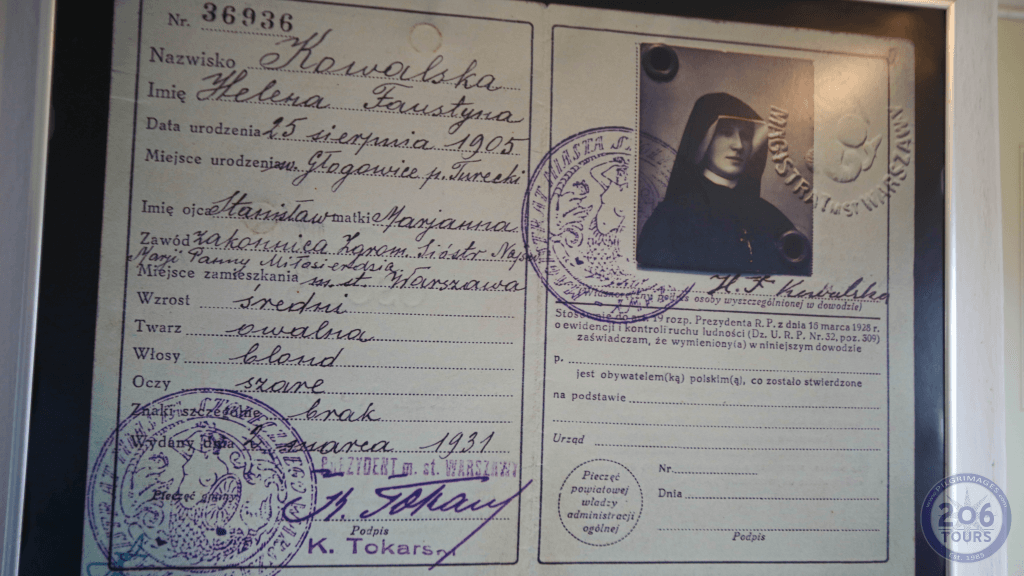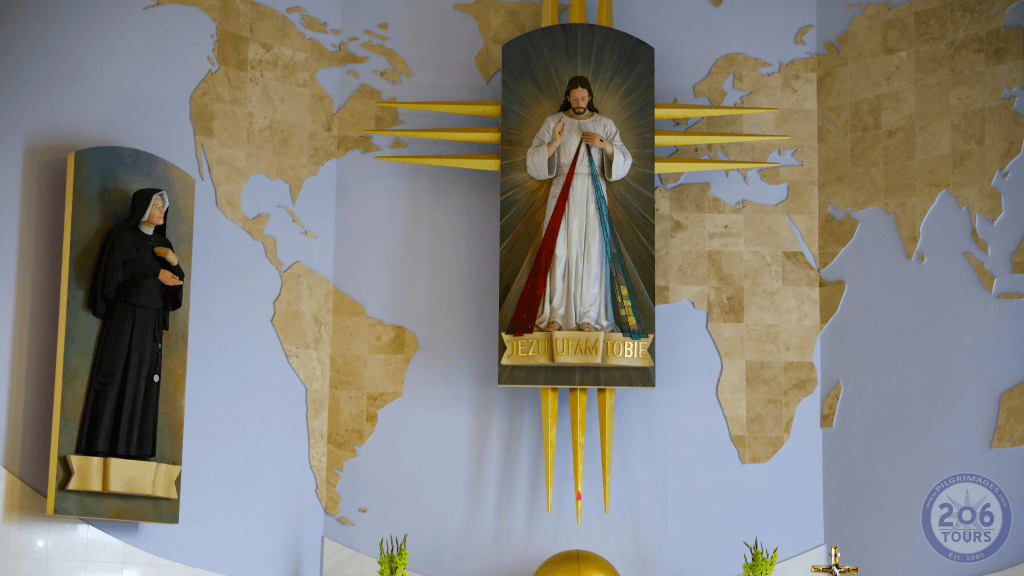Month: September 2018
“We can believe what we choose. We are answerable for what we choose to believe.” – Cardinal Newman
Congratulations to Father George W. Rutler for receiving the St. Paul Center Cardinal Newman Award. Fr. Rutler converted to Catholicism in 1979, and was ordained to the priesthood just three (3) years later. He served as chaplain for several organizations, and was a Parish pastor. Since 1988, Father has hosted a popular weekly program on EWTN. He has also written over twenty (20) books, and published hundreds of essays.
Held at the exclusive Union League Club in New York City last month, attracted hundreds of supporters and Catholics who all came together to honor Father George at the St. Paul Center’s Annual Cardinal Newman Award Dinner.
The St. Paul Center for Biblical Theology is a non-profit research and educational Institute that was started by Dr. Scott Hahn, in 2002. Dr. Hahn is a well-known speaker and author who in 1990 began teaching at the Franciscan University of Steubenville where he is now the Chairman of the Biblical Theology and the New Evangelization Department.
He founded the St. Paul Center with the goal of driving a revival in the study of Catholic Scripture, bring countless Catholics into an encounter with the life-transforming power of God’s Word, both in Liturgy and life. 206 Tours is a proud sponsor of the St. Paul Center, and has been close partners with Dr. Hahn for years.
Dr. Hahn’s latest project with 206 Tours is his upcoming Lenten Pilgrimage to the Holy Land, in which he will lead with his wife – Author and Steubenville Councilwoman: Kimberly Hahn. The Pilgrimage will follow the footsteps of Jesus from March 7 – 17, 2019.
Limits spots remain on this special tour, so sign up today!
Watch Dr. Hahn’s Personal Video to join him in the Holy Land Invitation
John Michael Talbot has become a household name to millions of Catholics due to his extensive artistic, musical, and humanitarian career. For decades, John Michael has been creating in the Catholic space, sharing his art as well as his message travelling from Parish to Parish. Here is a deeper look into the life, work, and service of this Christian Music legend.
John Michael Talbot was born into a Methodist family in Oklahoma City in 1954. Music had always been a large part of John Michael’s life, so much so that he dropped out of school and formed a country folk-rock band with his brother as a teenager. After several successful albums and years of touring, the band separated, and John Michael began a spiritual journey that ultimately led him to Christian Music.
John Michael became a Roman Catholic in 1978 while studying at the Franciscan center in Indianapolis, deeply inspired by St. Francis of Assisi. He founded an integrated monastic community of celibate men, woman, and families called Brothers and Sisters of Charity in 1980. He is currently the Minister General and Spiritual Father for the Brothers and Sisters of Charity in both Little Portion Hermitage in Arkansas and St. Clare’s Monastery in Texas.
After years of continued success in the world of Christian Music, John Michael founded his own record label, “Troubadour for the Lord” in 1992. He is currently regarded as Catholic music’s most popular artist. In his 37 years in the music industry, his latest album is his 53rd, contributing to the over 4 million records sales worldwide.
Click to watch a live performance from 2001
In addition to his extensive music career, John Michael had authored over 24 published books. In 2014, John Michael added the world of television to his creative resume with the highly acclaimed inspirational show called, “All Things Are Possible”, which ran for three seasons.
John Michael Talbot is uniquely creative, which makes his message deeply inspiring and motivational. At 64 years old, he is extremely active in traveling to parishes and spreading his message, like a modern-day St. Francis with the goal of renewing and reviving faith. His presence is in high demand as he is a powerful speaker, often invited to speak at Churches, and events – in addition to his busy touring concert schedule.
Next Spring, John Michael will travel to the Holy Land with fellow artistic Catholic Actor, Jim Caviezel. Pilgrims will have the once-in-a-lifetime opportunity to walk in Jesus’s footsteps alongside John Michael and Jim. John Michael will be sharing his musical talents throughout what is sure to be an unforgettable Pilgrimage to the Holy Land. Limited spots remain, don’t miss out on this amazing trip!
Watch John Michael’s Personal Invitation to join him in the Holy Land!
One of our very talented Spiritual Directors, Father Peter Dugandzic, recently led a 206 Tours Pilgrimage to Fatima, Spain, Lourdes & Paris. He has been extremely gracious in taking the time to document his journey in a Video Diary – which we are happy to share with you! Click to watch the videos below, get a glimpse into what a 206 Tours Marian Pilgrimage is about, and to feel as though you are right alongside Fr. Peter in Portugal, Spain, and France!
Day 1: Arrive in Lisbon
The group begins their Marian Pilgrimage in Lisbon, Portugal. Of all the things to see in Lisbon, the birthplace of St. Anthony of Padua is the most important. The group celebrated daily Mass at the Church that was built on the place where St. Anthony was born.
Day 2: Santarem & Fatima
The group celebrated Holy Mass in Santarem, at the Church of St. Stephen where a 13th century Eucharistic miracle occurred – before heading to the Shrine in Fatima. In Fatima, they visited the Hamlet of Aljustrel, the home of the three (3) shepherd children who witnessed Our Blessed Mother’s apparitions. After dinner, they joined the Rosary and Procession at the Shrine.
Day 3: Fatima
In the morning, the group celebrated Holy Mass at the Chapel of the Angel of Peace (Little Chapel of Apparitions) in Fatima before touring the Shrine, and learning about the miracle that happened more than 100 years ago. After lunch, the group did the Stations of the Cross. The path for the Stations is the same route the children took from their homes to where they tended their flock, and where they saw the Blessed Mother.
Day 4: Salamanca – Alba de Tormes – Avila – Burgos
On this day, the group journeyed to Salamanca – a beautiful University city with an old and new Cathedral. They embarked on a walking tour which concluded with Holy Mass in St. Martin’s Church. As part of our celebration, Fr. Peter blessed Pilgrims – George and Sandra – on their 32nd Wedding Anniversary!
Day 5: Avila
After departing from Salamanca, the group made their way to the village of Alba de Tormes, the place where Saint Teresa of Avila founded the Carmelite Monastery in 1571. While there, they celebrated Holy Mass, and had an opportunity to venerate St. Teresa’s remains. They continued to Avila to pray in the chapel where St. Teresa was born, and enjoyed the well preserved – and beautiful – 11th century architecture of the city.
Day 6: Loyola and Lourdes
On this day, the group traveled to Loyola, the birthplace of St. Ignatius – and had the opportunity to visit his home, as well as celebrate Holy Mass in the room where he underwent his conversion. They proceeded to Lourdes, with a remarkable view of the Pyrenees Mountains. After dinner, they walked to the Shrine for the spectacular Rosary Procession.
Day 7 & 8: Lourdes
After Holy Mass at the Chapel of St. Gabriel, the group toured the city of Lourdes and the holy places from the life of St. Bernadette. Some of those sites include Boly Mill where she was born, the Grotto of Massbielle where Our Lady first appeared to her in 1858, the miraculous spring that has cured many, and the healing baths. The group then joined the Eucharistic procession where there is a special blessing for all the sick and infirm – here Fr. Peter said a special prayer for all of us!
On this day Father Peter was asked to be the main celebrant for Mass in the Grotto, and a few of our 206 Tours Pilgrims served as Lectors. After Mass, the group walked the Stations of the Cross – which are uniquely carved into a mountain with life-sized figures featured in the Stations. The group offered a special prayer at the 12th Station.
Day 9: Paris & Lisieux
The group left Lourdes to fly to Paris where the celebrated Mass at the famous Basilica, Sacre Coeur, which translated means, “Sacred Heart”. The Basilica sits atop Montmartre Hill with a stunning panoramic view overlooking Paris.
Day 10: Lisieux
In Lisieux, the group visited the Basilica of St. Therese, and admired the magnificent mosaics and stained glass within. St. Therese was also known as “The Little Flower” and called, “the greatest Saint of modern times” by Pope Pius X. The group had the opportunity to view relics of her family, tour the Carmelite Convent she attended, and see her childhood home, Les Buissonets.
Normandy – Landing Beaches – American Cemetery
The group then made their way to Normandy, the site of D-Day. Together they visited the Normandy American Cemetery, and Memorial to honor and pray for the many brave American soldiers who died on D-Day and in Europe during World War II. Watch Fr. Peter’s moving video from this experience.
Day 11: Chartres
In Chartres, the group celebrated Holy Mass at the massive Cathedral Notre Dame. Here they observed the incredible stained-glass windows from the 12th and 13th century which is widely revered as one of the highest points of French Gothic Art.
Day 12: Paris
On the group’s final day of their Pilgrimage, they went to Rue de Bac and celebrated Mass at the Shrine of Our Lady of the Miraculous Medal – which holds the remains of St. Catherine Laboure. Then they toured the city of Paris, visiting the church of St. Vincent de Paul, returned to Notre Dame Cathedral, and the Eiffel Tower.
For fourteen (14) days, Father Peter and his fellow Pilgrims visited many holy sites, Shrines, and Churches in the experience of a lifetime. We thank Father Peter and his group of Pilgrims for giving us the opportunity to share in their experience through this wonderful video diary.
To learn more about taking part in your own Marian Pilgrimage, view the full itinerary here:
Pilgrimage to Fatima, Spain, Lourdes & Paris.
For more videos like these, SUBSCRIBE to our YouTube page!
[DISPLAY_ULTIMATE_SOCIAL_ICONS]
On September 20, 2018, we honored the 100th Anniversary of Saint Padre Pio’s Stigmata – and – Sunday, September 23th, marks the 50th Anniversary of his death. We would like to give Special Recognition for the example he set for us and for his service to all Catholics.
Stigmata
Saint Padre Pio is famously known for his stigmata, visions, and the gift of healing. His stigmata first appeared on September 20th, 1918 while he was hearing confession. The Stigmata directly mimics Christ’s Crucifixion and Passion wounds on his hands, feet, and side. The wounds had a floral odor, often referred to as the, “odor of sanctity”, and the Stigmata was perceived by many as evidence of holiness. With much skepticism surrounding Saint Pio, he was investigated many times, but all the doctors commissioned by the Holy See confirmed his Stigmata is to have been a gift from God.
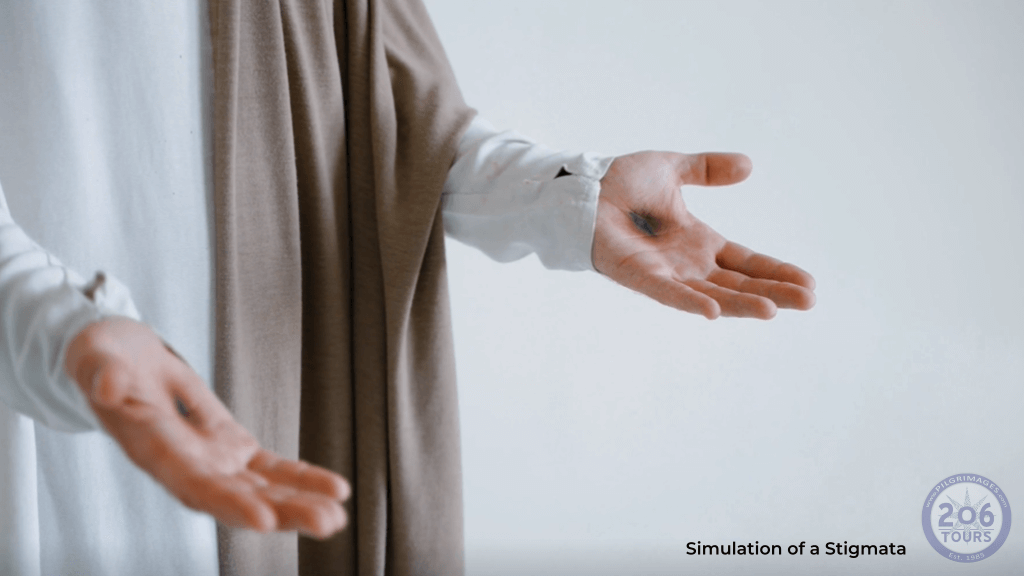
Superhuman Qualities
Connection to St. John Paul II
Death
As Jim Caviezel prepares to make his way to Israel in 2019, and walk the true Via Dolorosa, let us take a look back at the role that set him apart – and one that he will reprise next year.
The making of the film, The Passion of the Christ, was so extraordinary and unusual that it has been the subject of countless articles, books, and even televised Specials. Much of what made the film so unique is the experiences that lead actor, Jim Caviezel who plays Jesus Christ, endured while filming the movie. Rather than regret taking the role, or looking back on his experience with contempt, Jim has widely been known to say the experience brought him closer to God and his Catholic Faith. Here are some interesting details about Jim’s experience acting in the highest-grossing Independent film of all time.
1. Gibson offered him the role, then tried to talk him out of it
Mel Gibson Directed, Produced, and funded the entire film. When he originally set up a meeting with Caviezel, he said he wanted to discuss a film about a surfer as a ruse to get Jim to take the meeting. After presenting the idea of the film about the last hours of Christ’s life, and Jim accepted the offer, Gibson tried to change his mind.
At the 2018 SEEK Conference, Jim shared; “[Mel] said, ‘You’ll never work in this town again.” So I told him, ‘We all have to embrace our crosses’ … We have to give up our names, our reputations, our lives to speak the truth.”
2. Jim had turned the role of Jesus down before
Jim was asked to portray Jesus twice before Gibson approached him – once for a Play, and once for a television Special. Both times, he immediately knew the roles were not right. When he heard Gibson’s pitch though, he knew the story would be told in a way he was proud to represent. He said he knew this version would show “the absolute fullness of the truth” of what Jesus endured in his last few hours, and that that was the only way he would ever portray Christ.
3. A headache of a make-up process
Most days, Jim needed to be on set by 2 am to endure hours of make-up application. Gibson’s vision included making Jesus as realistic as possible for a man born in that region at that time. Jim wore a prosthetic nose and brown contacts – they even raised his hairline. For much of the filming, he wore makeup that made it look like his eye was swollen shut, which affected his depth perception and vision, causing migraines.
4. Jim endured lots of physical ailments
While filming what has been recognized as one of the most graphic and violent films ever made, there was no shortage of real injury and pain – mainly suffered by the lead actor. In keeping with the goal of authenticity to the horrors suffered by Jesus, Jim was put in very precarious and potentially dangerous spots. He suffered scratches and bruises from the chains he wore and even dislocated his shoulder carrying the 150-pound cross, which was captured on film and kept in the movie. While filming the scene where Jesus delivers the Sermon on the Mount, Jim and the Assistant Director, Jan Michelini, both were struck by lightning just minutes apart. This was the second time Jan was struck during the project.
Jim hung on the cross in below-freezing temperatures and strong wind, which almost caused hypothermia – leading to pneumonia and a lung infection. During the scourging scene, Jim was accidentally whipped twice by the two actors portraying Roman soldiers, one of the hits leaving a 14-inch gash in his back.
5. Through the pain, his Faith never wavered
During an interview on The Today Show, Jim shared how challenging making the film was for him. He shared how he turned to prayer when he was struggling, exhausted, overwhelmed, and doubtful. He said he wasn’t sure if he was going to be able to handle the pain or maintain the physical and emotional endurance needed to complete the film. Jim shared that he needed to listen to his heart rather than his head to get through the filming process.
As a devout Catholic, Jim felt the process forced him to become closer to God and his Faith. He said that when he was at his most doubtful, he turned to prayer;
“It forced me into the arms of God. That’s the only place I could go. That’s when God’s voice came to me. ‘Hey, don’t you worry about it. Let me take care of it, and will you allow me to use you to play?’ And that’s when I just said, All right, I’m going to let you perform, and I’m going to step out of the way.”
As we mentioned in an earlier blog post, in January of 2018, Jim confirmed the rumors that he would be reprising his role as Jesus Christ in Gibson’s upcoming sequel which is said to follow the three days after Jesus’s death and explore his Resurrection.
In April of 2019, Jim will be joining 206 Tours on a Special Pilgrimage to the Holy Land in preparation for the role. There are limited spots available, reserve your spot today!
[DISPLAY_ULTIMATE_SOCIAL_ICONS]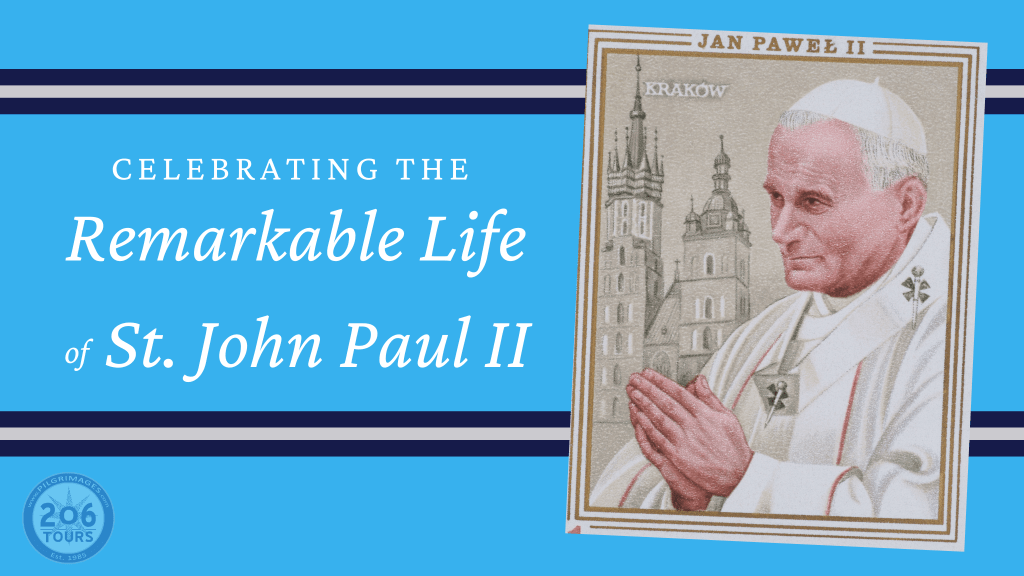
The Centennial (100th) Birthday of Saint John Paul II, took place on May 18, 2020. His life of service and eternal life of Sainthood is so remarkable and has changed the lives of countless people. Here are some interesting facts about the remarkable life of the famous Polish Pontiff.
St. Pope John Paul II was born Karol Józef Wojtyła in Wadowice Poland. When he was just a young boy, his mother died in childbirth and before he was 20 years old, he had also lost his brother and father. After his father’s death in 1941, he began courses at the clandestine underground seminary which was run by the Archbishop of Krakow. Several times, he escaped death in freak accidents and even avoided the Gestapo, which, to him, confirmed his calling to become a priest.
Throughout the Nazi regime, while still a seminarian, he is attributed with saving the lives of several Jewish children which led to him receiving the medal of a “Righteous Among the Nations”. In 1946, he was Ordained on All Saint’s Day. Just a year later, when visiting and confessing to Saint Padre Pio, St. Padre Pio shared a prophecy that he would someday ascend to the highest post in the Church.
In 1953 he began teaching Ethics at the Jagiellonian University where he gathered a small group of young people, who affectionally referred to themselves as “Rodzinka” or “little family”. They often met for prayer and enjoyed activities like skiing and kayaking together. The group grew to about 200 people and Saint Pope John Paul II became known as “Wujek”, the Polish word for “Uncle”. Upon being named Auxiliary Bishop of Krakow, he assured his little family, “Wujek will remain Wujek”. This nickname is still affectionately used mostly by Polish Catholics.
As a participant in the Synod of Bishops, he had a good relationship with Blessed Pope Paul VI. He was appointed the Archbishop of Krakow by Pope Paul VI in 1964 and subsequently played a key role in creating the encyclical “Humanae vitae”.
He was elected Pope on October 16, 1978 – and remained Pontiff until his death in 2005, making him the second longest-serving Pope in modern history. One of the most popular Pontiffs, he often attracted large crowds – like in 1995 when nearly four (4) million worshipers came to see him at the World Youth Day in Manila. The Vatican recognizes this as the largest Papal gathering ever!
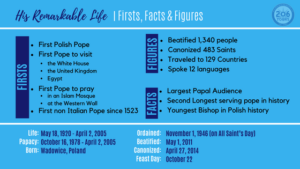
Catholics in Poland, and all over the world, still maintain a deep love for Saint Pope John Paul II, and will no doubt celebrate his life on what would have been his 100th Birthday. Many will travel to Poland to walk in his footsteps and make a spiritual Pilgrimage. Learn all about this Pilgrimage, here: Tour 168
We remember all the lives that were lost on September 11, 2001. In the days that followed, we came together as a nation, finding connection and unity in our grieving, our sadness, our hope, and our strength. As a country, and as brothers and sisters all over the world, we continue to mourn nineteen (19) years later, we pray for peace.
Let us pray for:
- All those who lost their lives that day are at home with Jesus.
- All the families who lost loved ones find healing and take comfort knowing our Lord’s promise of eternal life and everlasting joy.
- All the survivors and for all heroes who selflessly risked or gave their lives for us.
In remembrance, let us pray together for healing and peace;
“Father of all, God of all nations, we give you thanks for the mystery of infinite compassion and love expressed in the covenant of creation and renewed through the blood of the new and everlasting covenant shed by your Son, our Lord Jesus Christ, for the salvation of all people.
With our brothers and sisters of other world faiths, we employ your mercy and pray for an end to violence.
May all people live together in peace and tranquility, recognizing your own divine image, giving you praise and glory here on earth and together forever in your kingdom as you live and reign Father, Son, and Holy Spirit, one God forever and ever.”
Amen.
God Bless America!
[DISPLAY_ULTIMATE_SOCIAL_ICONS]
On Sunday, February 22, 1931, through the mediation of St. Faustina, Christ passed on the message of Divine Mercy at Lagiewniki in Poland. As the 20th Anniversary of her Feast Day approaches, we reflect on her incredible life and the miracle of Divine Mercy.
St. Faustina was born Helena Kowalska, to a poor but religious family in Poland in 1905. She joined the convent at the age of 20, taking the religious name, Sister Maria Faustina of the Blessed Sacrament. While assigned to a convent in Plock, Poland – St. Faustina developed an illness that required her to rest for several months at a nearby farm.
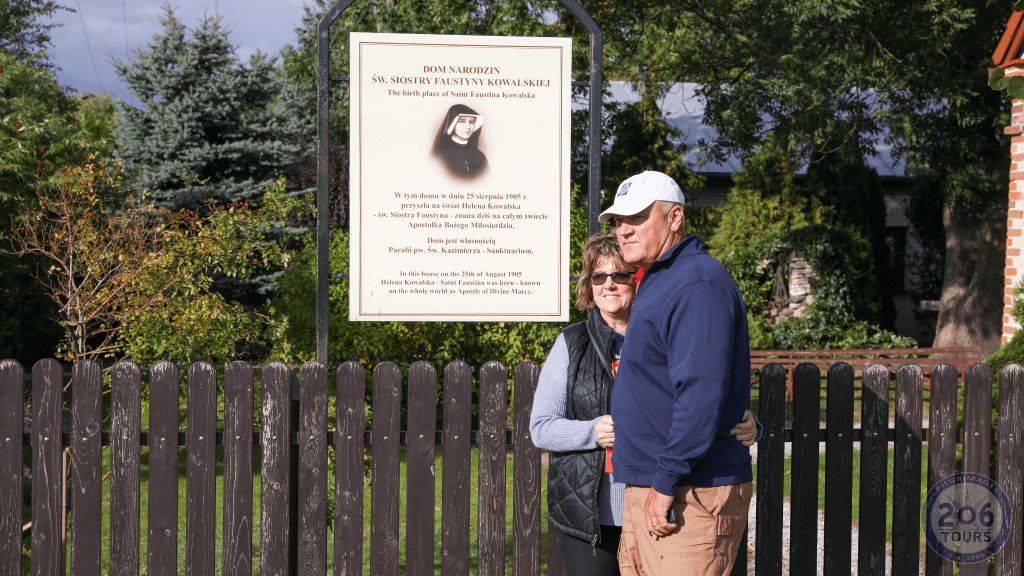
On the night of Sunday, February 22, 1931, Jesus appeared to her wearing a white garment with colorful rays emanating from His heart. She details in her diary that Jesus told her that the first Sunday after Easter is to be celebrated as the Feast of Mercy, and that he wished His image as he appeared before her be venerated and displayed for all to see.
Though she could not paint, she promised to venerate this image. After a few years, with the help of Father Michał Sopoćko, she commissioned artist Eugene Kazimierowski to create the painting what has now become the famous image of Divine Mercy. It is accompanied by the phrase “Jezu ufam Tobie” or “Jesus, I trust in You.” The image has been replicated and distributed countless times, however, the original painting now resides at the Divine Mercy Sanctuary in Vilnius, Lithuania.
For years, St. Faustina conversed with Jesus and devoted her life to His mission of spreading Divine Mercy. Through her steady and impassioned work, the message of Divine Mercy did spread rather quickly through the distribution of brochures, books, and prayer cards. Divine Mercy became a source of inspiration and strength for the Polish people, as just before her death in 1938, St. Faustina predicted that a terrible war was approaching. By 1941, the image and message of Divine Mercy had reached many countries, even as far as the United States.
The main message of the Divine Mercy devotion is to ask for, and receive, the Mercy of God through consistent confession, to trust in Jesus’ Mercy, and to show mercy to others as God would.
In the 1950s, both Pope Pius XI and Pope Pius XII personally spread messages of, and approved the devotion to, the Divine Mercy. St. John Paul II was an ardent supporter of St. Faustina and Divine Mercy – and so he Beatified her in 1993, and Canonized her on April 30th, 2000. Surprisingly, he closed the Canonization by officially designating that Sunday after Easter as the “Feast of Divine Mercy”. Coincidently, St. John Paul II died in Saturday, April 2nd, 2005 – on the eve of Divine Mercy Sunday. He was later Beatified by Pope Emeritus Benedict XVI on Divine Mercy Sunday in 2011, and Canonized on the Holy day in 2014 by Pope Francis.
The legacy and strength of the message of Divine Mercy has not wavered, much in part due to the loyalty and perseverance of St. Faustina and those who honored her legacy. St. Faustina now lies at the Divine Mercy Shrine in Lagiewniki, Poland. As her October 5th Feast Day approaches, we take this opportunity to reflect on her devotion and trust in the Mercy of Jesus. In April of 2020, many Catholics will make a Pilgrimage to Poland to celebrate the 20th Anniversary of Divine Mercy Sunday and the Canonization of St. Faustina, to learn more about how you can join, visit www.206tours.com/stfaustina
Lithuania & Poland – 20th Anniversary of Divine Mercy Sunday
Tour: DM042025
Destinations: Poland
Duration: 11 days
Lithuania & Poland – Feast of St. Faustina
Tour: SF1005
Destinations: Poland
Duration: 11 days

